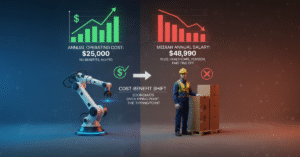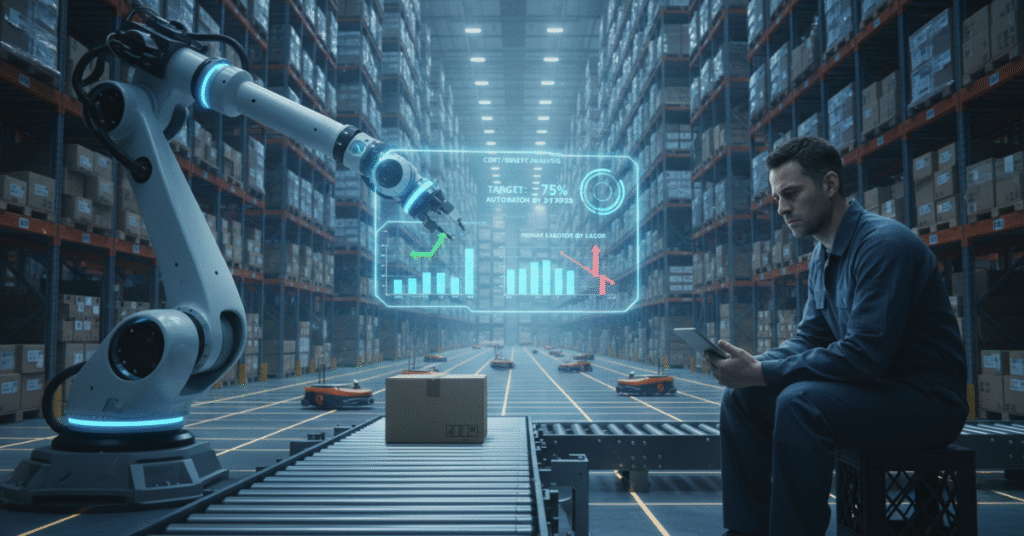Why is Amazon replacing human workers with robots? This is one of the most pressing questions of the modern age. This shift is not just about technology; it’s about the fundamental future of employment across the globe.
Recent reports, based on leaked internal documents, reveal Amazon’s massive plan to automate over 600,000 jobs by 2033. This strategy is set to redefine what it means to work in a fulfillment center.
However, to truly understand the root cause of this operational shift, we must look past the fear of job loss and examine the core economic truth.
Our latest fact confirms that the annual operating cost of an AI-powered robot has now dipped below the average salary of a human warehouse worker. When technology becomes cheaper, faster, and more reliable, the transition becomes a business necessity.
The Core Answer: Economics Over Empathy
Amazon’s guiding principle has always been hyper-efficiency and aggressive cost reduction. Their entire business model is built on delivering goods faster and cheaper than anyone else.
If you are looking for the definitive answer to Why is Amazon replacing human workers with robots?, the explanation lies squarely in the cost-benefit analysis of its operations. The decision prioritizes commerce over human sentiment. We will not only look at why Amazon is replacing human workers with robots, but also understand its cost-benefit analysis.
Robot Cost vs. Human Salary: The Tipping Point
Our analysis confirms that Amazon’s robotics division has drastically driven down the costs of deploying and maintaining its advanced robotic units.
Crucially, robots do not require benefits, pensions, health insurance, or paid time off. This significantly reduces their lifetime operational expense.
This makes them a more profitable asset than a human worker, whose median full-time salary currently sits around the $47,990 mark.
This is the single most compelling driver. Amazon anticipates saving an astronomical $12.6 billion in labor costs between 2025 and 2027 alone through automation.

The Power of Pennies: $0.30 Saved Per Item
The economic case is further solidified when looking at the granular level.
Amazon aims to reduce the cost to process each item—including picking, packing, and shipment—by approximately 30 cents.
When a company ships millions of packages daily, these seemingly small savings compound rapidly into massive, multi-billion dollar profits.
In the cutthroat e-commerce landscape, achieving this level of cost reduction provides Amazon with an unparalleled competitive advantage.
Beyond Cost: Operational Imperatives Driving Automation
The decision to automate is not solely monetary; it also addresses significant operational challenges within its large fulfillment networks that humans create.
Solving the High Turnover Problem
One of the largest hidden expenses for Amazon is high employee turnover—the rate at which workers quit or are fired. This constant churn requires costly recruitment and training.
Robots eliminate this problem entirely. They do not quit due to fatigue, nor do they take “Time Off Task,” a metric used to track worker productivity.
By mitigating human attrition, Amazon ensures a stable, predictable, and fully staffed warehouse operation, which is crucial during peak seasons. This operational stability is the real reason why Why is Amazon replacing human workers with robots.
Guaranteed Speed and Precision
Robots operate with a level of speed, precision, and predictability that human workers cannot consistently match. A machine will execute a task identically every time.
This predictability is essential for Amazon’s sophisticated, AI-driven logistics system. It ensures that delivery promises, such as those made to Prime members, are reliably met without human error slowing the system.
The Hidden Truth: Where Automation Falls Short (An Expert’s View)
As an industry analyst, my experience observing these shifts suggests a crucial point often overlooked: Automation, while powerful, is not yet perfect. The final answer to Why is Amazon replacing human workers with robots? is that they are aiming for optimization, not total replacement.
The Automation Paradox: Higher Injury Rates
Paradoxically, data shows that fulfillment centers utilizing robotics often have higher serious injury rates for human workers than non-automated facilities.
This is because humans must now work at the relentless pace set by the machines, performing repetitive and awkward movements to keep up.
The robot handles the heavy lifting, but the human is subjected to monotonous physical strain. This ethical and safety flaw is often ignored by major reports focused only on efficiency.
The Enduring Need for Human Adaptability
Robots excel at structured, repetitive tasks, but they inevitably fail when confronted with novelty or complexity.
When an item falls, a machine malfunctions, or an order has an unusual problem, human adaptability, critical thinking, and fine-motor skills are irreplaceable. When you look at the large scale, the question isn’t what Amazon is doing, but why is Amazon replacing human workers with robots so fast?
For this reason, Amazon is not seeking to eliminate all human workers. Instead, it is changing their roles. The future Amazon employee will be a robot supervisor, maintenance specialist, or complex problem solver.
FACTOVATE’s Final Takeaway: The Reality of the Labor Future
When all factors—economic, operational, and technological—are weighed, the driving force behind Amazon’s strategy is clear. Why is Amazon replacing human workers with robots? Because the cost-effectiveness and scalability of automation far outweigh the ongoing expense and volatility of human labor.
Amazon’s goal of automating 75% of its operations by 2033 is a clear signal to the global workforce.
The jobs that require physical endurance and repetition are on the way out. This shift demands an urgent focus on skills that robots cannot replicate: creativity, emotional intelligence, advanced problem-solving, and machine management. The human workforce is not being eliminated; it is being prepared for a new, more complex role.

